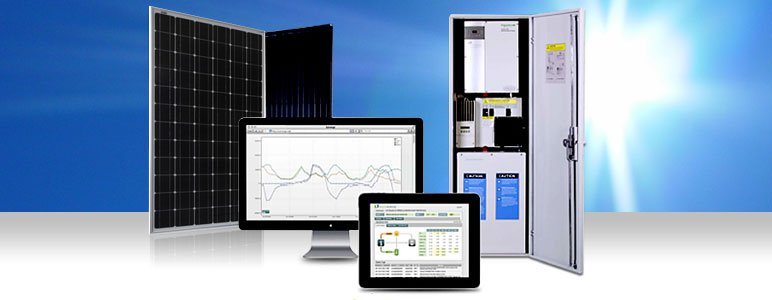

Battery systems are becoming a crucial component of expanding solar’s growth
While California continues exponential growth in solar energy with rooftop system installations more than doubling in the past two years, solar really isn’t reaching its full potential among small to medium-sized businesses. Two major drawbacks hindering commercial solar adoption are its intermittent production and an inability to meet the instantaneous needs for increased electricity that businesses often require.
Originally published Jan. 26, 2015, in the San Diego Business Journal in the special section “Sustainable San Diego.”
Coming to the rescue are a variety of companies offering turnkey systems that store excess solar energy on-site rather than releasing it onto the utility grid. This ability to capture energy locally for later use – during periods of increased demand or when the sun isn’t shining – greatly improves solar’s value proposition.
Energy storage is particularly advantageous for business because in addition to paying for kilowatt-hours (kWh) consumed, commercial utility customers pay monthly electricity demand charges based on their highest usage, or “peak demand,” within the billing cycle. Peak demand can account for as much as 60 percent of a business’s monthly utility bill.
In San Diego, peak demand drives energy costs from about $20 per kilowatt (kW) at low demand periods to $42 per kW during high demand periods. Energy storage can shave off the expensive demand spikes by discharging electricity as needed and provide reliable backup power during grid disruptions and blackouts.
California takes charge
“Energy storage and solar power have a synergistic relationship that is just beginning to be fully realized,” said Rebecca Feuerlicht, a CSE project manager. “Recent state legislation setting specific goals for energy storage deployment and the extension of generous state rebates are giving a boost to the solar and energy storage industries.”
California is the first state to mandate energy storage as part of the major utilities’ energy portfolios. Legislation passed in 2014 directs the state’s investor-owned utilities to procure 1,325 megawatts (MW) of energy storage by 2020, largely to support utility-scale integration of additional solar and wind energy. However, residential and commercial consumers also benefit as 200 MW of the storage mandate is required to be installed “behind the meter” at customer sites.
The state’s energy storage market received another boost in June 2014 when Governor Jerry Brown authorized renewal of the state’s Self-Generation Incentive Program (SGIP) through 2020. The extension authorizes $83 million per year for behind-the-meter generation technologies, including rebates for stand-alone storage systems and those paired with solar or other distributed generation systems. SGIP rebates generously pay up to 60 percent of the total cost of energy storage systems.
Energy storage systems
While a variety of energy storage systems are available from several companies in differing configurations, they are typically about the size of a refrigerator and use lithium-ion battery packs charged from on-site solar power or power purchased at nonpeak hours from the grid. By incorporating advanced computers, proprietary software and cloud-based technology, systems allow the supplier to seamlessly monitor and automatically manage a site’s overall power use with minimal effort required by the customer or utility.
Costs for on-site energy storage systems start at tens of thousands of dollars and go up, but can achieve payback in as few as three to five years through California rebates, federal tax credits and utility savings achieved by time-shifting energy consumption and avoiding high peak demand charges.
Most suppliers also offer leases or power purchase agreements that avoid or lower up-front costs and provide monthly payments businesses can cover with utility bill savings. Recently, some companies have started offering to install, operate and maintain systems with a revenue-sharing agreement based on utility bill savings.
Integrated solutions
According to Jon Fortune, director of regulatory and energy services at Sunverge Energy, Inc. of Stockton, Calif., solar integrated storage is much more than a back-up battery in a box. Beyond supplying reliable electricity and keeping utility costs low for customers, individual solar-storage systems can be linked into networks of utility-scale resources by forming a virtual power plant capable of storing, shifting and balancing power to reduce electricity costs for all utility customers. Sunverge’s interests are not simply about local energy storage, Fortune says, but extend to aggregating resources to provide value to consumers, utilities and society “without leaving anyone in the dark.”
“Integrated solar-storage systems aggregated in the cloud can support grid needs by dispatching power when and where it is needed. This helps reduce the costs and complexity of managing the distribution grid and in doing so accelerates wider adoption of solar and other renewable energy sources,” Fortune said.
Sunverge’s first major test of how well its system works to assist with utility-scale energy management started last August in Sacramento at a small urban housing development called 2500 R Midtown. They outfitted 34 energy-efficient homes with individual 2-kilowatt solar photovoltaic (PV) systems connected to energy storage. Developer Pacific Housing and Sunverge have joined with the Sacramento Municipal Utility District to evaluate the benefits of solar-storage systems.
Local solar storage
A public benefit corporation, Pacific Housing develops low-income housing throughout California. In San Diego, they contracted with Sunverge to install a solar-storage system at the affordable apartment community Carlton Country Club Villas in Santee. A 3.2-kilowatt solar PV system combined with 4.5 kilowatts of storage serves the property’s office and outdoor common area lighting to help lower management costs.
The system maximizes bill savings by leveraging SDG&E's small commercial time-of-use tariff to offset site demand during peak pricing periods with excess solar generation. Carlton Country Club Villas is saving about 20 percent annually on their common area utility bill after paying the lease for the system, which would have cost about $40,000 to purchase. Sunverge utilizes third-party lease financing, which allowed the project owner to receive a $10,800 rebate from the SGIP for the battery storage equipment and, because it is integrated directly with solar, leverage the federal solar investment tax credit.
The Carlton Country Club Villas solar-storage installation is toward the smaller end for commercial use, but serves as a good example of how systems are scalable down to a single enterprise or household.
Energy storage rebates
According to Rebecca Feuerlicht, SGIP manager in San Diego, some $415 million of rebate funds are available from the program through 2020. For energy storage systems less than 30 kilowatts, incentives are paid up front, while those over 30 kilowatts are paid half up front and half based on performance over five years. Currently rebates are $1.46 per watt based on a two-hour rating for batteries. A 20-kilowatt-hour battery discharged over two hours would yield a 10-kilowatt rating times $1.46 for a $14,600 rebate.
Janice Lin, co-founder and executive director of the California Energy Storage Alliance, sees the SGIP as a catalyst for energy storage, playing a key role in its adoption much like it did for solar PV during the early 2000s.
“Solar in California would not be as successful as it is without the SGIP and now the program is set to do the same for energy storage,” Lin said at an energy storage workshop sponsored by CSE in November. “Solar-storage systems are a way to manage and operate the state’s electric power system more efficiently – that’s good for everybody.”

